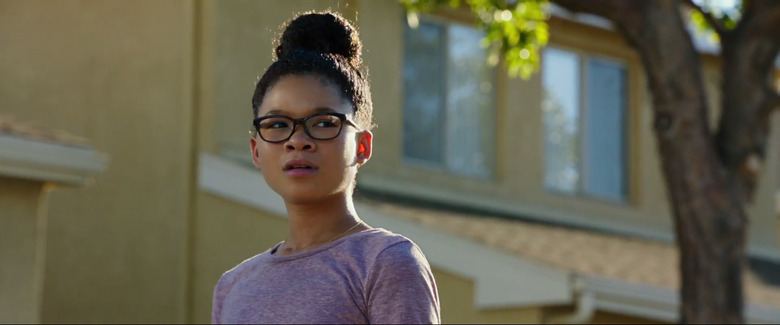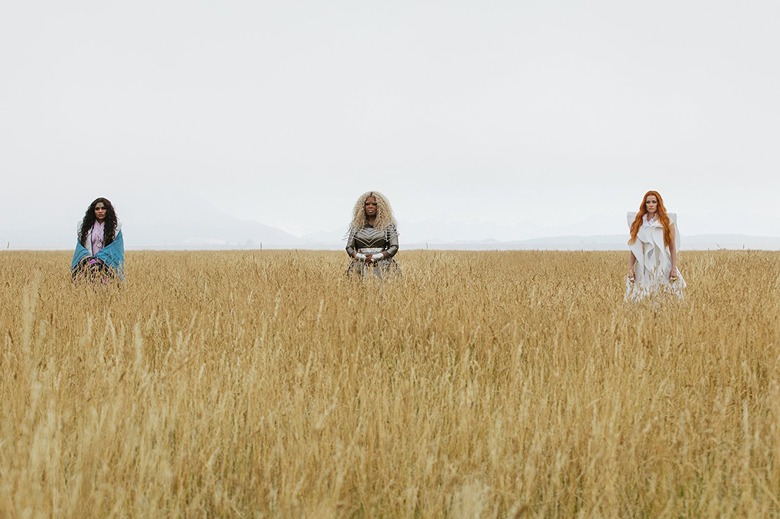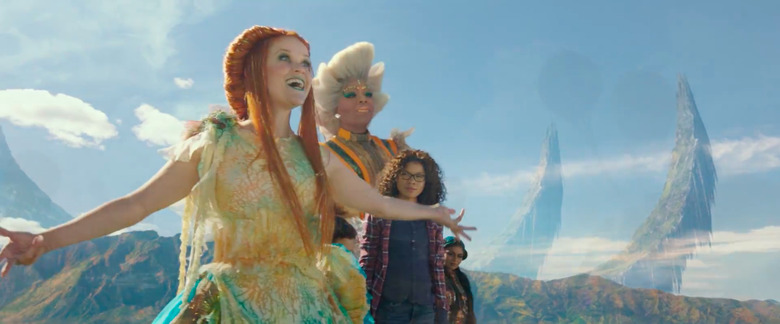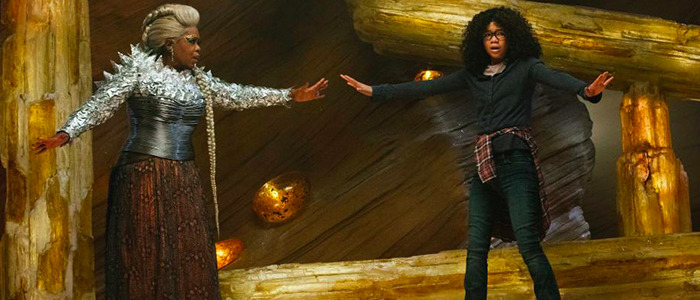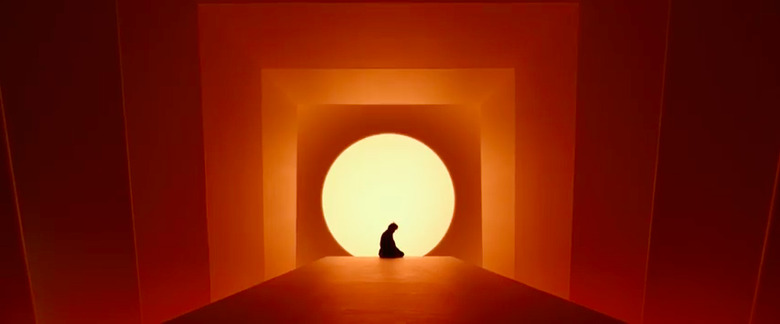'A Wrinkle In Time' Spoiler Review: A Heartbreaking Misfire With A Powerful Burden
(In our Spoiler Reviews, we take a deep dive into a new release and get to the heart of what makes it tick...and every story point is up for discussion. In this entry: Ava DuVernay's A Wrinkle in Time.)
I'm going to start this A Wrinkle in Time spoiler review a little differently than normal. I think we, as a critic and audience, should be honest with each other for a moment.
Some of you out there might not be aware of this, but there's a certain burden that comes with being a woman of color in the film criticism space. To be truthful, I don't feel this burden all of the time, but I always know it's there. As I'm surprised to find, writing this review for A Wrinkle in Time happens to be one of those times in which I distinctly feel the pressure I'm under as a black woman to like and laud A Wrinkle in Time, to support director Ava DuVernay. But I can't honestly do that. The film has a multitude of issues that must be addressed.
However, the film itself can also be reviewed on two different levels: how it performs as a film for children and how it performs as a film for adults.
The message of A Wrinkle in Time
The best aspect of A Wrinkle in Time is its message, which can be boiled down to Oprah Winfrey's line "Be a warrior." The line isn't my favorite way of summing up the film's message, which I think could be more aptly said as "you matter."
Indeed, the concept of mattering is central to the story, and it's where the film's heart lies. In my adult head, I could see what wasn't working thematically and where scenes needed better direction, better conceptualization, and more attention. But Meg Murry's (Storm Reid) journey towards finding herself hit home with me in a personal way, in a way the child in me could recognize and appreciate.
I'm sure that if I was a 13-year-old, I'd be all over this movie simply because of Meg. Even though I grew up during the '90s, which had plenty of black programming, I still never really saw myself, a girl who was intensely unsure of herself, insecure, and self-degrading. I can honestly say I hated myself growing up, just like Meg, and like her, I wanted to come back to myself as someone different. I wanted to be the girl that I thought boys liked. I wanted to be the girl that would be seen as popular and not just "smart." I didn't want to be a dork.
If I'd seen Meg's journey as a kid, I would have felt a lot more confident about myself, especially with regards to matters of the heart. I would have realized that I had everything I needed to be a self-assured, vibrant, attractive person. People can forget how important it is for tweens and teens to see that the attributes they hate most about themselves can actually be the attributes that attract people the most. Seeing Meg get complimented by Calvin (Levi Miller), someone she considers out of her league, is special since it's he's complimenting the two things black and biracial girls are often told aren't beautiful – her intelligence and her coily, non-Eurocentric hair. I feel a lot of girls will come away from this film feeling like they can finally do away with their fantasies of being "the cool girl," since as we see in the film, the cool girl (Rowan Blanchard) has her own set of problems, too.
Even better is seeing Meg slowly learn how to stand up for herself and how to love herself. The quote from Rumi that acts as a driving force throughout the film – "The wound is the place where the Light enters you," is something I needed to hear as my adult self. Too often, we forget that all of our emotional baggage is cluttering up the spot where we can actually find ourselves. Like Meg, we're often too afraid to actually look in those dark spaces and get to the answers. I guess to that end, the line "be a warrior" makes sense; we have to be warriors of our own lives in order to master ourselves. That's basically what this intergalactic journey was for Meg; a journey of self-discovery and self-mastery.
In short, the importance of A Wrinkle in Time can't be understated. It is, without a doubt, an important film. But its importance shouldn't be measured by our adult standards. It needs to be measured by the message it hopes to instill in kids, especially girls who are vulnerable to all types of societal propaganda about what it means to be a woman. This film wants all kids to grow up as self-empowered, confident warriors of the Light, who fight for what's right even when it's uncomfortable or unpopular to do so. Regardless of what you think about the film, this is a message that can only do good for its young viewers.
However, this film can be viewed from both the eyes of a child and the eyes of an adult. So it's time to switch from my kid point of view to my adult one. And boy, does my adult self have a lot to say.
A film full of nitpicks
Ava DuVernay succeeds in bringing the film's heart to the forefront. But somehow, she has failed with everything else. As far as actual filmmaking goes, I wanted to like this film more than I do.
Nearly every other aspect of this film falls apart, so much so that it's hard for me to even know where to begin dissecting it. On the whole, the film feels cheap, despite it being a Disney-financed film. The two biggest inklings I got that maybe the film's budget was weirdly allocated were the CGI treatment of Winfrey's Mrs. Which, and the transformation of Mrs. Whatsit (Reese Witherspoon) into a huge cabbage dragon.
I understand that Mrs. Which's true form is a larger than life being, but it seemed surprisingly lazy to showcase Mrs. Which as just a large bust. Why couldn't we have seen all of her? A skyscraper-sized Mrs. Which would have been scary, intimidating, and formidable, perfect to contrast her maternal, otherworldly nature. But instead, it seems like corners were cut with the presentation of Mrs. Which in the movie. It's all too clear to see that it's just Oprah standing in front of a green screen, with computer magic fading the rest of her body out.
Similarly, it's confounding as to why Mrs. Whatsit never speaks when she's in her dragon-esque form. We've seen plenty of films with CG characters talking – heck, the recent Planet of the Apes series is one that relies solely on the power of CG animals speaking dialogue and signing. We have become used to seeing CG characters do extraordinary things, so it's no great stretch to expect to see Mrs. Whatsit say something, especially when Calvin falls off of her back in midair. I was instantly reminded of early Pixar shorts, which showed inanimate objects full of life, but never speaking. Clearly, the talent for creating Mrs. Whatsit's dragon form is there, but it seem like the time wasn't.
The camera techniques create odd tonal shifts in the story; for several scenes, handheld "shaky" cam is used, making you feel like you're in a completely different (and much more intense) movie than the kid-friendly adventure you paid for.
The film itself clunkily sets up the story, deciding not to fully immerse us in Meg's world but to instead give us the highlights of her life. She's bullied at school. Her principal (Andre Holland) inexplicably doesn't understand why she's lashing out, even though the entire school should know how much Meg gets teased by mean girl Veronica (Rowan Blanchard) and that it's the four-year anniversary of her father's (Chris Pine) disappearance. She knows amorphous science facts about her father's work, work that is never explained in any logical way in the film.
These sound like nitpicks, but where A Wrinkle in Time falls apart is that there are tons of nitpicky moments that add up to an irritating movie-going experience.
A film with no ground rules
Fantasy can suffer from the conceit that nothing needs to make sense because it's "fantasy." But in truth, fantasy stories still work like any other story; they use ground rules to give the viewer or reader structure and, as the term implies, ground them in their new environments. Take the Lord of the Rings trilogy, for example. Even though it's a fantasy, it's completely grounded in a detailed world with its own set of politics and social structures. A more flighty film, Luc Besson's The Fifth Element, plays a little more into fantasy cliche of "anything goes," but still, there's enough backstory to situate you in a world in which a strange woman is the missing key to the universe.
Unfortunately, A Wrinkle in Time fails to set up any ground rules. We know we're supposed to be having fun on an intergalactic trip, but we don't know how we're doing it or where we are half of the time. We never understand the true importance of these worlds. We never get lost in the beauty or even the horror of it all; the closest we come to that is on the verdant planet Uriel, where Meg and her compatriots are treated to a field of talking flowers. But our time on the planet doesn't amount to much; as we're looking at the world with Meg and her friends via a flight on Mrs. Whatsit's back, the flight doesn't actually amount to anything. It ends as Calvin falls off Mrs. Whatsit and is buoyed by the flowers. Our exploration is cut short, and our ability to get fully immersed is limited.
Adventures on these worlds are supposed to be the meat of the film, but annoyingly, they are hastily set up. The worlds we go to are basically empty sets, and much of the magic that could have been imbued in these worlds is missing. We don't even know how these worlds work, such as Camazotz, the more mercurial planet we visit, which changes its guise from a 1950s nightmarescape to an overcrowded beach. Sure, it's to trick Meg, Calvin, and her brother Charles Wallace (Deric McCabe). But usually when characters are trapped in living environments meant to deceive them, the environment turns into something they might be familiar with or somehow have some connection to. Camazotz doesn't do this; it draws scenarios out of thin air and expects us to go along with it. Not to compare it to Star Wars or Star Trek, but both of those properties go to great lengths to make their unrealistic worlds feel lived-in and tactile. Perhaps Besson's Valerian and the City of a Thousand Planets is a more apt comparison; despite it being a box office failure, it still did its best to immerse its audience in a world unlike any they've seen.
We're told characters like the Mrs., including the quote-attributing Mrs. Who (Mindy Kaling) and the Happy Medium (Zach Galifianakis) are mystical beings, but we never know why they are such or how they came to be. We never know why the It, the bacteria-like villain in the movie, wants to take over people's inner light. We don't even know how tessering works, or why it works, or how Meg's dad figured it out. We don't know a lot of things, and it's frustrating. Nothing ever makes sense, and it would have been a relief if just something, at some point, followed some rules.
But there are none, and I was left feeling more and more frustrated the more the film progressed. Yes, my kid at heart was having fun with the messages of the film, and to the film's credit, scenes involving spreading that message are the most powerful. But the adult me was mad. Where was the magic I was promised? Where were the thrills I was led to believe I would get? I was angry that I was let down by the film. But I was even angrier that it was DuVernay who had let me down.
This film, and DuVernay herself, have a lot of pressure riding on them, and I hoped for DuVernay to turn this one out, if only so I wouldn't have to be faced with the hard task of discussing the unfair burden put on black and POC-led films, the burden of being perfect in order to succeed, while films with white leads just have to be average to be considered successful.
The burden of A Wrinkle in Time
A Wrinkle in Time is a bad film if we're just going by filmmaking standards. With that said, though, A Wrinkle in Time is a film that has the burden of perfection placed on its shoulders, and it's a burden it shouldn't have to carry. The only reason it does is because of the politics and social environment surrounding this film. For many black audiences and POC filmgoers, A Wrinkle in Time's success is paramount for the progression of inclusive films.
The film, seemingly a passion project for Ava DuVernay, comes at a critical moment when black filmmaking – and black creativity in the mainstream as a whole – is experiencing a watershed moment unlike any we've seen since the 1970s. As added pressure, the film comes right after the biggest film ever featuring a black cast, director and crew: Black Panther. As we've seen this week, that film has surpassed $1 billion in less than a month. It takes standard "successful" blockbusters months to achieve that feat, and a black-led film has done it in record time. Not only has the film been monetarily successful, it's become a cultural lightning rod, sparking conversations around the world and even changing the minds of people who had only been fed a diet of stereotypes about blackness. Look to the many Korean moviegoers who talked about how Black Panther changed their lives and their attitudes towards the black diaspora. This paragraph is not meant to wrongly compare A Wrinkle in Time to Black Panther as if they are the same type of movie. It is just important to illustrate the environment of high expectations A Wrinkle in Time has been birthed into.
The expectations the film has placed on itself are high – this is a film that stars newcomer Reid as Meg Murray, reimagined as a biracial girl struggling to fit in. Her adopted brother Charles Wallace, also a biracial character, is played by fellow newcomer McCabe, a Filipino-American boy. Meg's parents, played by Pine and Gugu Mbatha-Raw, depict the rare interracial relationship on screen. Mrs. Who, Mrs. Whatsit, and Mrs. Which are all multiracial, multicultural beings played by Kaling, Witherspoon and Winfrey. It's a film championing diversity, inclusion, representation; words that have since become cliche in some circles, but words that still carry the messages Hollywood wrestles with itself to understand.
If you've read the various arguments online, there's a fear that some reviewers out there are simply giving this film a bad analysis just because they're against social progress. This fear is not unfounded; just look back to Star Wars: The Last Jedi, which saw a certain segment of "fans" sabotaging the film's critical reception just because the film had the nerve to showcase women (including women of color) and men of color in leadership roles. The Last Jedi's predecessor, The Force Awakens, was attacked by the same scared white dudes who felt a black man couldn't be the lead of a Star Wars story, somehow forgetting about Lando Calrissian's presence in the Star Wars canon. Even Black Panther itself was the subject of a Rotten Tomatoes attack by racists before Facebook and Rotten Tomatoes shut down the group's mobilization.
This trend has been increasingly more bold, but it's also not anything new. Historically, bad reviews have hurt films starring black actors and other actors of color, giving Hollywood execs the excuse to go back to their comfortable corners and declare "ethnic" films as bad for business. Meanwhile, bad reviews have never hurt films starring white actors and featuring white directors; Michael Bay keeps making awful films, and somehow he stays employed.
A Wrinkle in Time shouldn’t be the only film of its kind
The fear is that a multitude of bad reviews will plague A Wrinkle in Time and prevent Disney and other big studios from taking chances on films featuring non-traditional casts and directors. Clearly, that's been weighing heavily on my heart and mind as I've written this review.
A lot of the pressure would be off the film – and by extension, reviewers like me – if Hollywood simply allowed films made by all people, featuring all people, to exist. DuVernay should be given the grace and space to fail, and to fail spectacularly. Michael Bay fails spectacularly all the time! And yet he still gets employed. Colin Trevorrow fails – Jurassic World wasn't that great and is often downright regressive – and yet he was given the opportunity to direct a Star Wars (a project he has since departed). Steven Spielberg, someone we typically think of as moviemaking teflon, has had flops, and yet studios still flock to him for films. I could go on and on, but you get the idea – these directors all have something in common, and it's what differentiates them from an Ava DuVernay. White men get second chances; POC creators and women creators rarely do.
If there were more A Wrinkle in Times out there, I could just review this without caring about the impact of my words. If Hollywood were truly egalitarian, there'd be a plethora of films out there that tell stories about and for everyone. So while A Wrinkle in Time ultimately loses the battle of filmmaking, it still wins the war of instilling hope into younger generations. Little girls who love film can see DuVernay doing great things and start to dream higher of themselves. They can also look to Meg and see how Meg overcame her difficulties and take those lessons into their own lives. It also puts pressure on Disney and other companies to start making more films that cater to more people.
A Wrinkle in Time might not be a good film, but it's a good starting point for more films like it.

